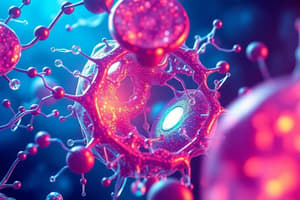Podcast
Questions and Answers
What are the three principles of cell theory?
What are the three principles of cell theory?
- Cells are the smallest unit of life, cells can arise spontaneously, and all cells contain genetic material.
- All cells have the same structure, all cells are capable of photosynthesis, and all cells communicate with each other.
- All living things are composed of cells, cells are the basic units of structure and function, and all cells arise from pre-existing cells. (correct)
- Cells maintain homeostasis, cells can exist independently of each other, and all cells have a nucleus.
How do ribosomes assist in the function of a cell?
How do ribosomes assist in the function of a cell?
- By transporting substances across the cell membrane.
- By synthesizing proteins which are necessary for cellular functions. (correct)
- By generating energy through ATP production.
- By storing genetic information for cell replication.
Which of the following accurately describes the function of the Golgi apparatus?
Which of the following accurately describes the function of the Golgi apparatus?
- To regulate the flow of materials in and out of the cell.
- To synthesize proteins and process polypeptides.
- To modify, sort, and package proteins for secretion or delivery. (correct)
- To store waste products and excess substances.
What is the key difference between passive transport and active transport?
What is the key difference between passive transport and active transport?
Which of the following correctly identifies what happens during the S phase of the cell cycle?
Which of the following correctly identifies what happens during the S phase of the cell cycle?
Which property of the phospholipid bilayer primarily contributes to its role in cell membrane fluidity?
Which property of the phospholipid bilayer primarily contributes to its role in cell membrane fluidity?
What distinguishes plant cells from animal cells?
What distinguishes plant cells from animal cells?
What best describes the role of cilia and flagella in cells?
What best describes the role of cilia and flagella in cells?
Which type of solution causes a cell to swell due to water influx?
Which type of solution causes a cell to swell due to water influx?
What is the primary purpose of checkpoints in the cell cycle?
What is the primary purpose of checkpoints in the cell cycle?
Flashcards
Homeostasis
Homeostasis
The ability of an organism to maintain a stable internal environment despite external changes.
Mitosis
Mitosis
The process by which a cell divides into two daughter cells that are genetically identical to the parent cell.
Interphase
Interphase
The period in the cell cycle when the cell grows and copies its DNA in preparation for cell division.
Organelle
Organelle
Signup and view all the flashcards
Active Transport
Active Transport
Signup and view all the flashcards
Passive Transport
Passive Transport
Signup and view all the flashcards
Differentiation
Differentiation
Signup and view all the flashcards
Stem cells
Stem cells
Signup and view all the flashcards
Cancer
Cancer
Signup and view all the flashcards
Carcinogen
Carcinogen
Signup and view all the flashcards
Study Notes
Cell Theory and Organelles
- Cell theory's three principles: All living things are made of cells, cells are the basic unit of life, and cells come from pre-existing cells.
- Prokaryotic vs. Eukaryotic cells should be differentiated with a Venn diagram showing characteristics common to both, and unique to each.
- Plant vs. animal cells: plant cells have unique structures, like cell walls, chloroplasts, and large vacuoles, not found in animal cells.
Cell Transport
- Dynamic vs. static equilibrium: dynamic equilibrium involves continuous movement while static equilibrium is stable. Homeostasis maintains equilibrium.
- Stimulus response and homeostasis: A stimulus triggers a response that maintains homeostasis, i.e., a regulated internal environment.
- Feedback loops: Positive feedback loops amplify a response, while negative feedback loops reverse a response (e.g., regulation of body temperature).
- Cell membrane role in homeostasis: The cell membrane regulates what enters and exits the cell to maintain homeostasis.
- Active vs. passive transport: Active transport requires energy, while passive transport does not. Six types of transport (exocytosis, endocytosis, facilitated diffusion, osmosis) and examples of substances transported should be included.
- Hypotonic, isotonic, and hypertonic solutions and the effect of each on cells. A picture illustrating the differences between the solutions could be helpful.
- Classify transport types as active or passive based on diagrams/descriptions. Classify solutions as hypertonic, hypotonic, or isotonic.
Cell Cycle and Cancer
- Order of events from egg to embryo including examples of cell specialization and stem cells.
- Levels of organization: From cells to organs to organ systems to organisms (increasing complexity).
- Purposes of cell division: Growth and repair.
- Phases of the cell cycle: Stages in detail, emphasizing the role of each phase, including the subphases of interphase, and mitosis (PMAT). The importance of interphase is critical in this case.
- Cytokinesis (plant vs. animal): The process in which the cytoplasm divides during mitosis /meiosis to generate two daughter cells.
- Checkpoint regulation and apoptosis ensure proper cell division and prevent cancerous cells with the explanation of the regulating role.
- Definition of tumours and the difference between benign and malignant tumours.
- Causes of cancer: A summary of potential cancer causes.
- Mitosis stages: Identifying the stage of mitosis based on descriptions or diagrams and evaluating consequences of failures in cell cycle.
- Differences in plant and animal cytokinesis.
Vocabulary
- Include definitions for concepts like homeostasis, solute, solvent, solution, concentration, differentiation, stem cells, cell cycle, chromosome, gene, and other terms in the provided list.
Studying That Suits You
Use AI to generate personalized quizzes and flashcards to suit your learning preferences.




